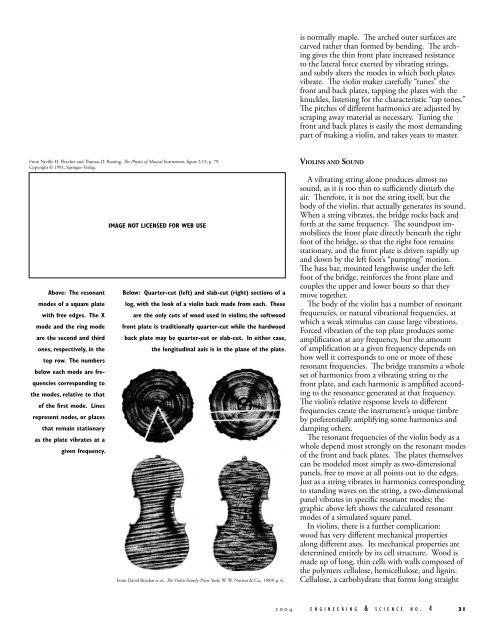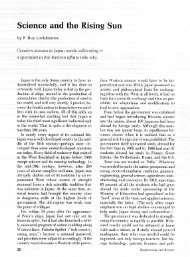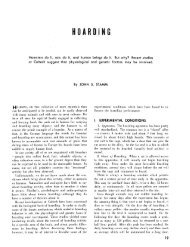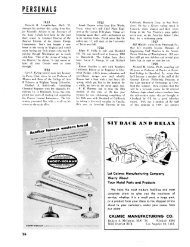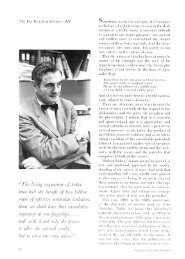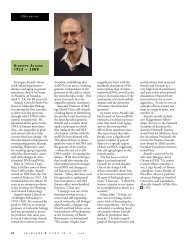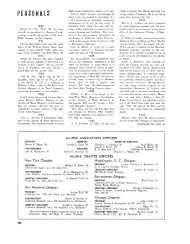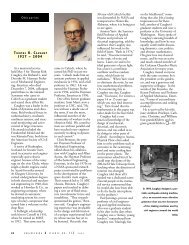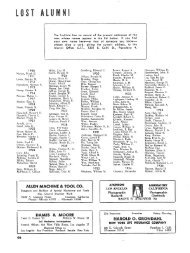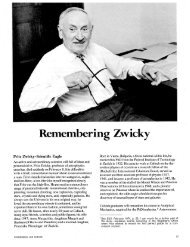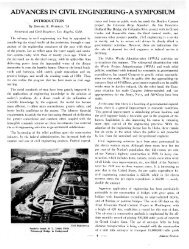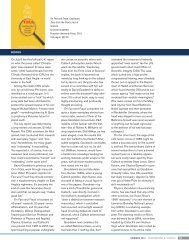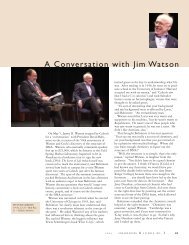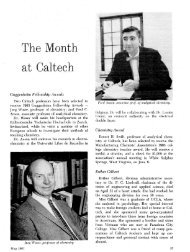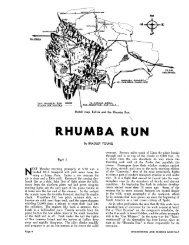The Science of Violin Making - Engineering & Science
The Science of Violin Making - Engineering & Science
The Science of Violin Making - Engineering & Science
You also want an ePaper? Increase the reach of your titles
YUMPU automatically turns print PDFs into web optimized ePapers that Google loves.
From Neville H. Fletcher and Thomas D. Rossing, <strong>The</strong> Physics <strong>of</strong> Musical Instruments, figure 3.13, p. 79.<br />
Copyright © 1991, Springer-Verlag.<br />
Above: <strong>The</strong> resonant<br />
modes <strong>of</strong> a square plate<br />
with free edges. <strong>The</strong> X<br />
mode and the ring mode<br />
are the second and third<br />
ones, respectively, in the<br />
top row. <strong>The</strong> numbers<br />
below each mode are fre-<br />
quencies corresponding to<br />
the modes, relative to that<br />
<strong>of</strong> the first mode. Lines<br />
represent nodes, or places<br />
that remain stationary<br />
as the plate vibrates at a<br />
given frequency.<br />
IMAGE NOT LICENSED FOR WEB USE<br />
Below: Quarter-cut (left) and slab-cut (right) sections <strong>of</strong> a<br />
log, with the look <strong>of</strong> a violin back made from each. <strong>The</strong>se<br />
are the only cuts <strong>of</strong> wood used in violins; the s<strong>of</strong>twood<br />
front plate is traditionally quarter-cut while the hardwood<br />
back plate may be quarter-cut or slab-cut. In either case,<br />
the longitudinal axis is in the plane <strong>of</strong> the plate.<br />
From David Boyden et al., <strong>The</strong> <strong>Violin</strong> Family (New York: W. W. Norton & Co., 1989) p. 6.<br />
2 0 0 4<br />
is normally maple. <strong>The</strong> arched outer surfaces are<br />
carved rather than formed by bending. <strong>The</strong> arching<br />
gives the thin front plate increased resistance<br />
to the lateral force exerted by vibrating strings,<br />
and subtly alters the modes in which both plates<br />
vibrate. <strong>The</strong> violin maker carefully “tunes” the<br />
front and back plates, tapping the plates with the<br />
knuckles, listening for the characteristic “tap tones.”<br />
<strong>The</strong> pitches <strong>of</strong> different harmonics are adjusted by<br />
scraping away material as necessary. Tuning the<br />
front and back plates is easily the most demanding<br />
part <strong>of</strong> making a violin, and takes years to master.<br />
VIOLINS AND SOUND<br />
A vibrating string alone produces almost no<br />
sound, as it is too thin to sufficiently disturb the<br />
air. <strong>The</strong>refore, it is not the string itself, but the<br />
body <strong>of</strong> the violin, that actually generates its sound.<br />
When a string vibrates, the bridge rocks back and<br />
forth at the same frequency. <strong>The</strong> soundpost immobilizes<br />
the front plate directly beneath the right<br />
foot <strong>of</strong> the bridge, so that the right foot remains<br />
stationary, and the front plate is driven rapidly up<br />
and down by the left foot’s “pumping” motion.<br />
<strong>The</strong> bass bar, mounted lengthwise under the left<br />
foot <strong>of</strong> the bridge, reinforces the front plate and<br />
couples the upper and lower bouts so that they<br />
move together.<br />
<strong>The</strong> body <strong>of</strong> the violin has a number <strong>of</strong> resonant<br />
frequencies, or natural vibrational frequencies, at<br />
which a weak stimulus can cause large vibrations.<br />
Forced vibration <strong>of</strong> the top plate produces some<br />
amplification at any frequency, but the amount<br />
<strong>of</strong> amplification at a given frequency depends on<br />
how well it corresponds to one or more <strong>of</strong> these<br />
resonant frequencies. <strong>The</strong> bridge transmits a whole<br />
set <strong>of</strong> harmonics from a vibrating string to the<br />
front plate, and each harmonic is amplified according<br />
to the resonance generated at that frequency.<br />
<strong>The</strong> violin’s relative response levels to different<br />
frequencies create the instrument’s unique timbre<br />
by preferentially amplifying some harmonics and<br />
damping others.<br />
<strong>The</strong> resonant frequencies <strong>of</strong> the violin body as a<br />
whole depend most strongly on the resonant modes<br />
<strong>of</strong> the front and back plates. <strong>The</strong> plates themselves<br />
can be modeled most simply as two-dimensional<br />
panels, free to move at all points out to the edges.<br />
Just as a string vibrates in harmonics corresponding<br />
to standing waves on the string, a two-dimensional<br />
panel vibrates in specific resonant modes; the<br />
graphic above left shows the calculated resonant<br />
modes <strong>of</strong> a simulated square panel.<br />
In violins, there is a further complication:<br />
wood has very different mechanical properties<br />
along different axes. Its mechanical properties are<br />
determined entirely by its cell structure. Wood is<br />
made up <strong>of</strong> long, thin cells with walls composed <strong>of</strong><br />
the polymers cellulose, hemicellulose, and lignin.<br />
Cellulose, a carbohydrate that forms long straight<br />
E N G I N E E R I N G & S C I E N C E N O . 4<br />
31


